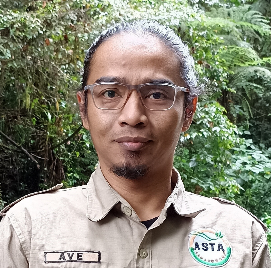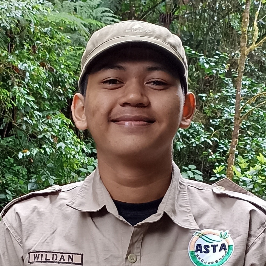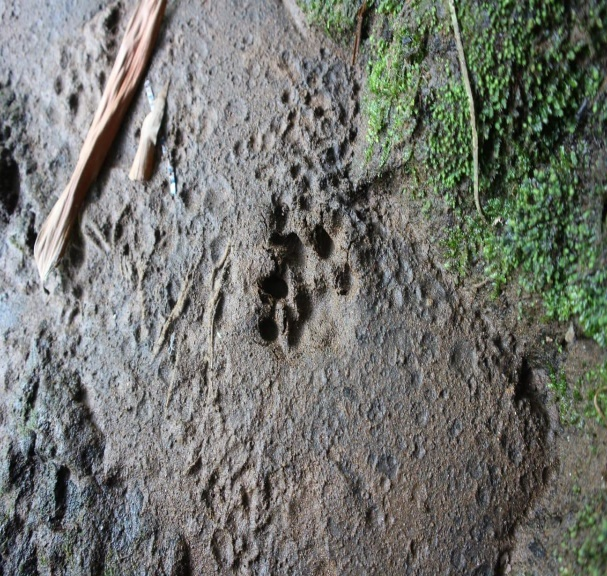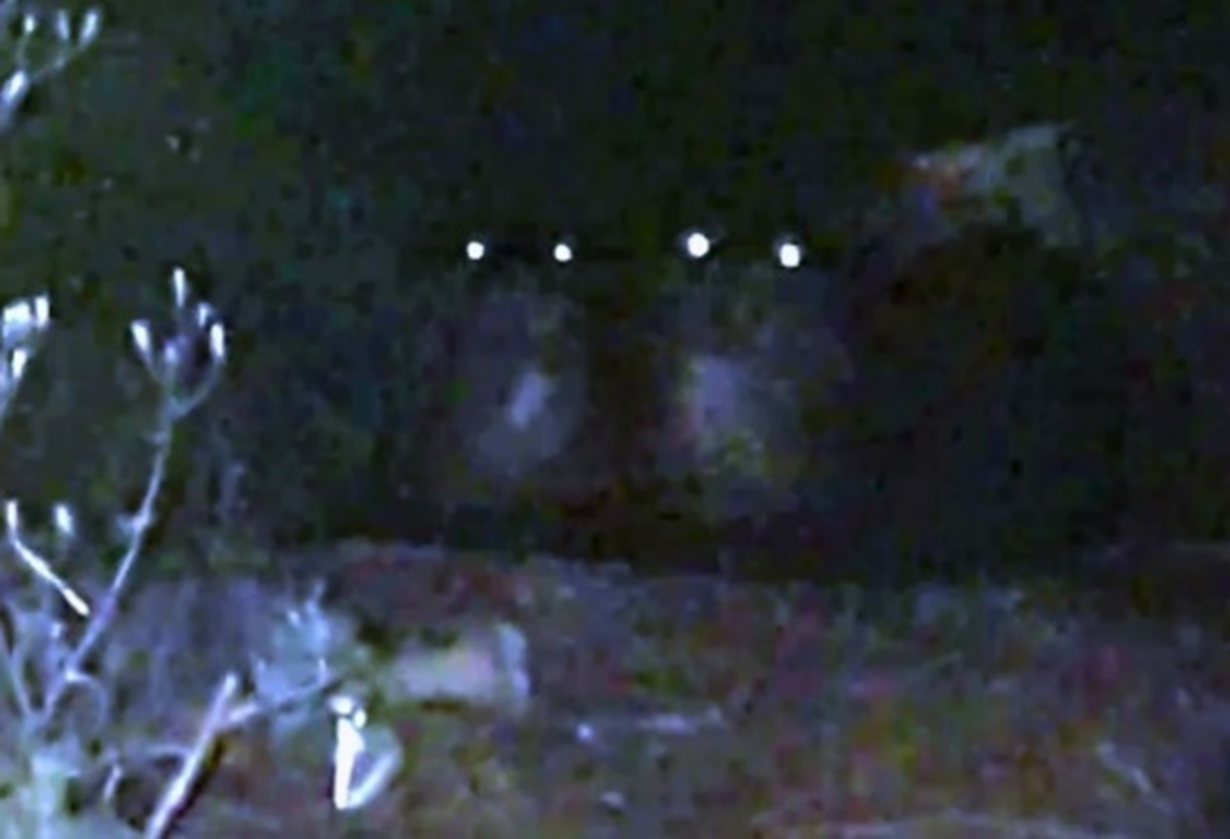IUCN/SSC Otter Specialist Group Bulletin

©IUCN/SCC Otter Specialist Group
Citation: Oktaliza,A., Abidin, M.A., Puspitasari, P., Geraldhi, K., Syah, W. and Andriyanto (2023). Sighting and Signs of the Small-Clawed Otter (Aonyx cinereus Illiger, 1815)in Ciliwung River, Indonesia. IUCN Otter Spec. Group Bull. 40 (3): 151 - 164
Sighting and Signs of the Small-Clawed Otter (Aonyx cinereus Illiger, 1815)in Ciliwung River, Indonesia
Averroes Oktaliza*, Muhammad Azib Abidin, Puti Puspitasari, Kevin Geraldhi, Wildan Syah, and Andriyanto
ASTA Indonesia, Jalan Pinding no. 25, Special Capital Region of Jakarta 12630, Indonesia
*Correspondance Email: ave.oktaliza@gmail.comReceived 31st January 2023, accepted 3rd May 2023
Abstract: The small-clawed otter (Aonyx cinereus) is classified as vulnerable on the IUCN Red List and has recently been upgraded to Appendix I on CITES due to significant population reduction and commercial trade. Despite increasing conservation efforts for otters worldwide, land conversion, waste, pesticides, and poaching pose significant threats to otter populations. Previous studies have identified the presence and habitat characteristics of Aonyx cinereus in various regions of Indonesia. However, more research still needs to be done on the Ciliwung River species. The field observation was carried out from August to October 2022; with most fieldwork happening in the rainy season, there are better times to sample otter markings. Spraints and latrine sites were the most commonly reported signs of otter presence. Two direct sightings of otters were made during the survey, one of a group of eight otters at Ciliwung Bridge and another of two otters searching for food along the riverbank at Blue Bridge. We confirmed the presence of otters in this area through visual encounters, sign surveys, and direct sightings. The proximity of Aonyx cinereus to settlements in the Jabodetabek region makes this species vulnerable to hunting. It is essential to preserve the Ciliwung River so that it may be passed on to future generations
Keywords: Habitat characteristics, field observation, conservation, protected species
INTRODUCTION
The small-clawed otter (Aonyx cinereus) has recently been elevated to Appendix I on the CITES due to commercial trade and is currently listed as vulnerable (VU) on the IUCN Red List due to a significant population decline. Otter conservation efforts are growing globally, but they are still threatened by things like poaching, pesticides, waste, and land conversion. It is believed that all four of Indonesia’s otter species are in decline because of habitat loss, pollution, conflicts with human, and poaching. However, there is a dearth of research and information on the status and habitat characteristics of A. cinereus.
Previous research has established the presence of A. cinereus and its habitat characteristics in a number of Indonesian provinces, including West Aceh, West Sumatra, West Java, and Eastern Java. However, little is known about the A. cinereus in the Ciliwung River, and this knowledge gap represents a significant gap in Indonesian otter research. Despite the absence of A. cinereus from the IUCN’s distribution map for the Ciliwung River, anecdotal evidence from nearby communities and river-conservation networks indicates that otters are still relatively common in the region.
The conservation issue of otters is getting more attention now. Land conversion, waste, pesticides, and trading are the major threats to otters worldwide (Foster-Turley and Santiapillai, 1990). There needs to be more information on wild otter populations in Indonesia. Still, we believe that all four species are in decline due to increasing loss and degradation of suitable habitat, impacts from environmental pollution, human-otter conflicts, and poaching for trade (Gomez and Shepherd, 2018). The importance of this study is highlighted by paucity of information on A. cinereus, particulary in the Ciliwung River watershed. There is need for current data on the presence and habitat characteristics of A. cinereus in the Ciliwung River Segment 4, Depok, West Java. Previous studies have been done in other regions of Indonesia. Small-clawed otters are endangered in the Jabodetabek region because of the widespread desire to keep and trade them, as shown by social media posts. As a result, the goal of this study is to close the information gap and offer current knowledge on A. cinereus in the Ciliwung River, which is essential for efficient conservation and management measures to safeguard this imperiled species.
There is still a lack of research or literature that discusses A. cinereus (Allen et al., 2019) in Indonesia. Several previous studies of small-clawed otter detected the presence and habitat characteristics of A. cinereus based on tracks, spraints, food scraps, latrine sites, and sliding sites. A. cinereus were found on the rice field, swamps, nipah/rumbia forest, and riverside in West Aceh (Ujong Nga, Samatiga), West Sumatra (Padang Pariaman), and West Java (Halimun National Park) (Melisch et al., 1996; Aadrean et al., 2010; Abdullah and Rasyid, 2015; Aadrean and Usio, 2017), and Eastern Java (Wonorejo Mangroves) (Rihadini et al., 2022). Feeding location, inventory of prey animals, and diet composition of A. cinereus from rice fields in Padang Pariaman were also studied (Aadrean et al., 2011; Andeska et al., 2021).
According to the IUCN distribution map, the small-clawed otter (A. cinereus) has yet to be found in the Ciliwung River, Indonesia (Wright et al., 2015). Nonetheless, according to data collected from Ciliwung River communities with active nature enthusiasts who reside near the Ciliwung River as part of a river-conservation network and social media, there are still relatively large numbers of otters visible.
The lack of knowledge regarding the small-clawed otter is one of the reasons why this research is vital, especially in the Ciliwung River watershed. Several previous studies have been conducted in Indonesia, such as Melisch et al. (1994), Aadrean and Usio (2017), Aadrean and Usio (2020), Andeska et al. (2021), Dirgantara et al. (2021), and Rihadini et al. (2022). Specifically, to get the most up-to-date information regarding the small-clawed otter's presence, particularly in the Ciliwung River Segment 4, Depok, West Java. With the strong interest of keepers and the wide coverage of the buying and selling of small-claw otters in the Special Region of Jakarta and surrounding cities (Jabodetabek) on social media, this will be a threat to the survival of this species.
Jabodetabek short for Jakarta-Bogor-Depok-Tangerang-Bekasi, is a metropolitan area in Indonesia that consists of the national capital city Jakarta, and four surrounding cities: Bogor, Depok, Tangerang, and Bekasi. With a population of over 30 million people, Jabodetabek is one of the most populous urban areas in the world.
THE STATUS OF SMALL CLAWED OTTER IN INDONESIA
As an indicator species, otters are regarded as ambassadors of freshwater ecosystems (Mason and MacDonald, 1986). Otters are wetland wildlife species that enrich Indonesian biodiversity, which is a source of national pride (Fig. 1). Otters are very important in safeguarding a balanced ecosystem in river watersheds, and can also act as indicators of wetland habitat conditions.
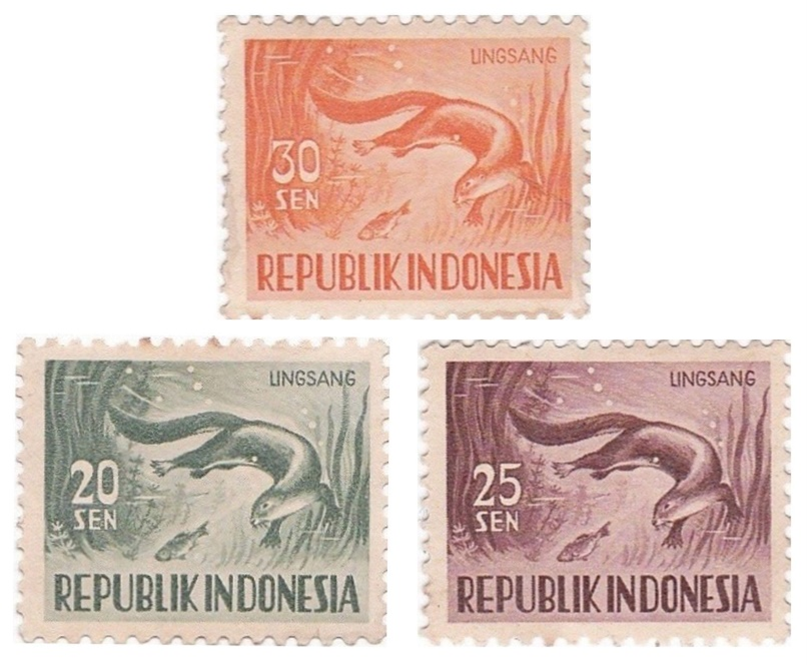
In Indonesia, Aonyx cinereus does not include protected animals based on Regulation of the Minister of Environment and Forestry Number P.20/MENLHK/SETJEN/KUM.1/6/2018. Lutrogale perspicillata has a conservation status in the IUCN is vulnerable, CITES is Appendix I, and is included in the list of protected animals in Indonesia. In fact, the Ciliwung River watershed is a non-conservation region, so an otter conservation effort is necessary in one of Jabodetabek's river watersheds, as well as basic information about the presence of otters in Jabodetabek.
STUDY AREA
The Ciliwung River is the major river that flows through the Special Region of Jakarta (Fig. 2). It is also the main river in the Ciliwung watershed, which is around 390 km2 and includes Jakarta and three satellite cities: Bogor District, Bogor City, and Depok City. The Ciliwung Riparian Area has a settlement occupancy rate of 9.53% in the upstream, 16.02% in the middle stream, and 89.72% in the downstream (Noviandi et al., 2016). Land use changes are inevitable, and the residential, industrial, office, and commercial uses in the Ciliwung watershed increased throughout the period 2010–2014 (Arifasihati and Kaswanto 2016; Permatasari et al. 2017). It contributes significantly to water pollution and expands impermeable terrain, hence increasing runoff and water discharge (Remondi et al. 2016). Aside from that, land use influences riparian habitat fragmentation, low input organic material, and plant variety, including ground vegetation (Moffatt et al. 2004)
This river faces the problem of changes in land cover as a result of the occupation of developed land along the river's riparian zone, which can worsen the impact of flooding farther downstream. As a transition zone between terrestrial and aquatic ecosystems, the riparian zone will lose its ecological function, particularly the conservation functions of biodiversity, water retention, and water absorption, if it is occupied by developed land.
On the basis of administrative area boundaries, the Ministry of Environment and Forestry of the Republic of Indonesia divides the Ciliwung River into six segments, one for each local government. The fourth segment of the Ciliwung River flows through two provinces, namely West Java Province and Special Capital Region of Jakarta. The fourth segment of the Ciliwung River extends for 24 kilometers through Depok City.
This research is conducted on the banks of Ciliwung River Segment 4. In a landscape dominated by human-altered regions, we evaluated the effect of diverse habitat types on the occupancy and intensity of habitat use by river otters along the Ciliwung River (Fig. 3). Segment 4 of the Ciliwung River watershed is dominated by bamboo woods. Compared to the devastation wrought by industrialization, the densely growing bamboo forests along the riverbanks have become a haven for wildlife, particularly otters.
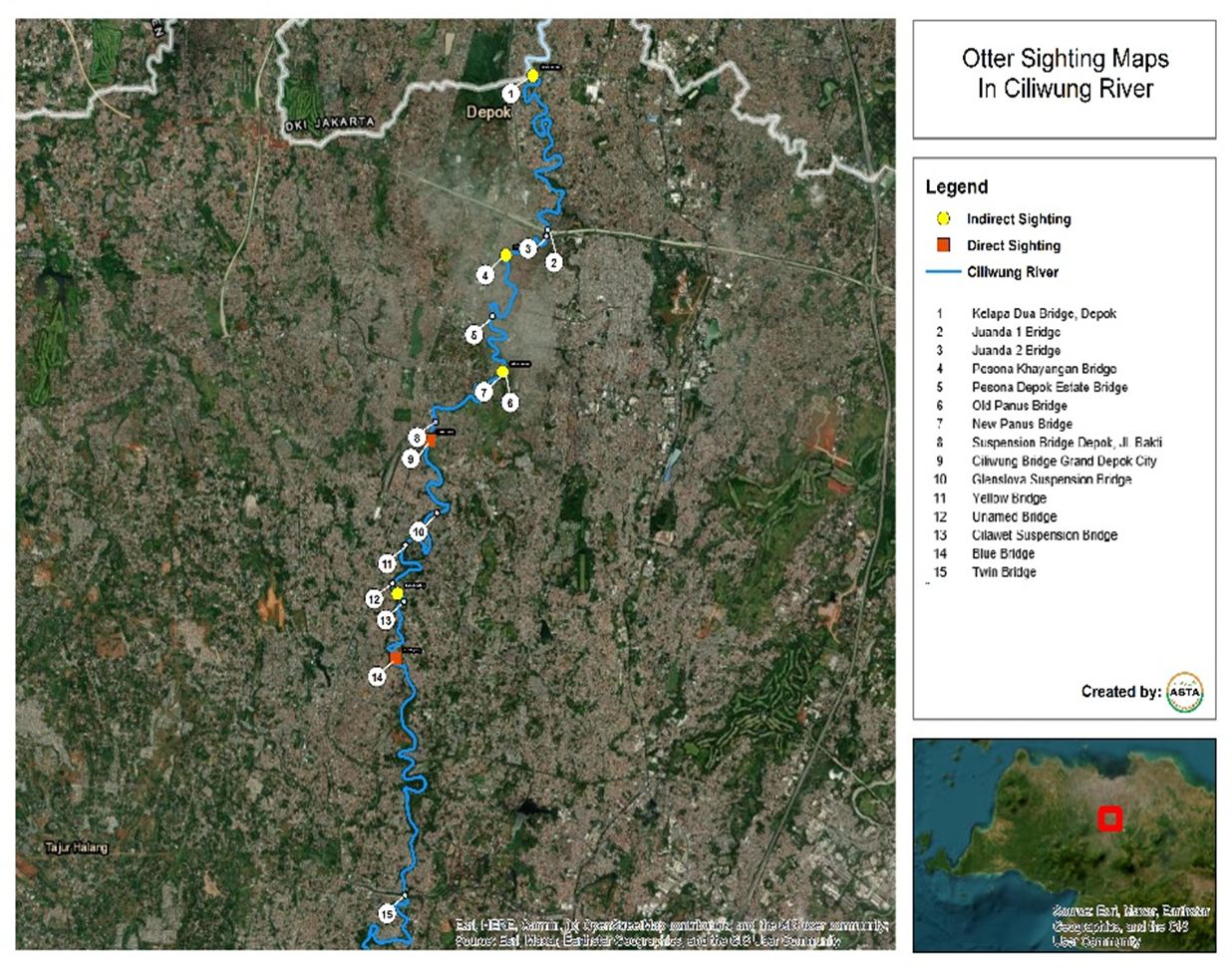
The vegetation near the Ciliwung watershed has been converted into settlements for the local citizens, causing damage to the ecosystem there (Saridewi et al., 2014), including otters. According to the IUCN Red List species distribution map (https://www.iucnredlist.org/species/44166/164580923), the Ciliwung River is home to a population of Lutrogale perspicillata but not Aonyx cinereus (Wright et al., 2015). The position of Aonyx cinereus in Indonesia, which is not listed on the list of protected species, captivates the interests of otter keepers and hunters, therefore increasing the danger to their survival.
MATERIAL AND METHODS
To check for the existence of otters, we closely collaborate with environmentalist communities that are widely dispersed in the Ciliwung River watershed. Informal conversations with the locals also serve as a reference for determining potential locations.
With local communities, volunteers, and environmentalist communities along the Ciliwung watershed, the survey was conducted using an interview and questionnaire based on a checklist (El Alami et al., 2020). Combined with those data, a field survey (monitoring) was conducted as far as 24 km of the Ciliwung River Segment 4 by walking. We confirmed the presence of otters in this area through visual encounters, sign surveys, and direct sightings.
In a landscape dominated by human-altered areas, we studied the impact of diverse habitat types on the occupancy and intensity of habitat use by river otters along Ciliwung River Segment 4 along the river. The standard otter monitoring method was used (Reuther et al. 2000). At each location, a maximum distance of 600 m was searched along the river watershed for spraints and tracks of otters. As soon as otter signs were found, the search was stopped, and the site was confirmed as positive. If no otter signs were found, then the site was recorded as negative. Binocular, infrared monocular, and DSLR cameras have been utilised. In actuality, we recorded fresh or old spraints, latrines, grooming sites, footprints, and otter dens (Mason & Macdonald, 1986).
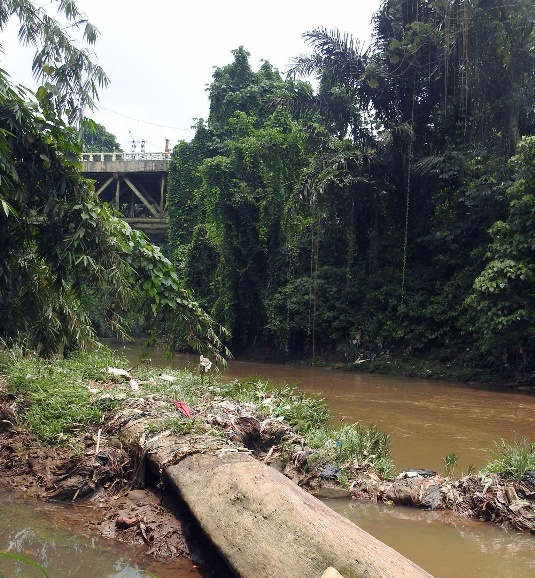
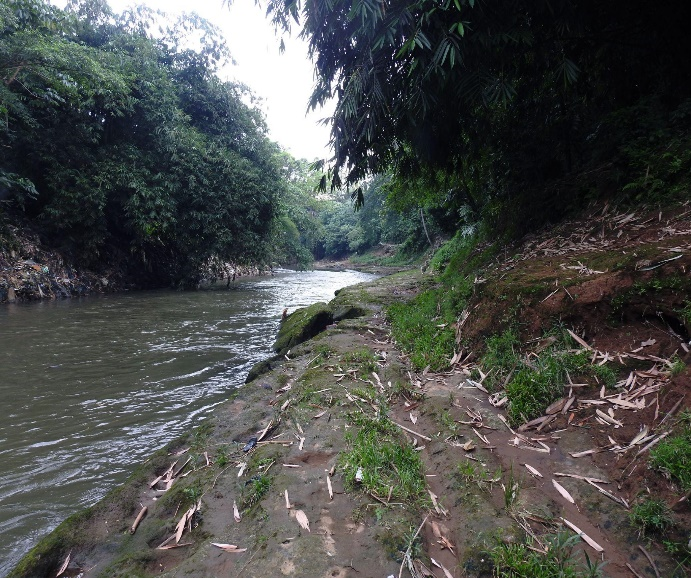
The observation began at the bridge along Ciliwung River Segment 4 (Fig. 3a, Table 1). At each site, the total number of spraints and tracks found under the bridge and along the bank was recorded. There were two reasons for choosing the bridges: the ease of approaching the river and the longevity of otter signs under the bridge cover (Macdonald and Mason 1988). All bridges were monitored during survey periods (August-October 2022), which were aimed to be as short as possible. For all surveys, the area under each monitoring bridge was checked for otter spraint on both sides of the river, and the encountered spraint was classified into three categories of freshness: (A) fresh spraint: still wet, intact shape, characteristic smell, color not yet faded; (B) spraint of intermediate freshness: dry but not yet dissociated and color not yet lost; (C) old spraint: dry, dissociated, and color faded (Schenekar, 2022).
RESULTS
In general, the search for otter signs in wet areas such as the Ciliwung River can be focussed on the adjacent dry ground, as they are key resting, nesting, grooming, and latrine site for all otters resident in the Ciliwung River.
The otter’s small-clawed footprints are particularly distinct, with lengthy middle toes on the forelegs and no claw impressions (Fig. 4). Small-clawed otters leave smaller footprints than smooth-clawed otters. In contrast to the otter’s traces, the fur is smooth and typically features claw marks and occasionally even clearly visible webs. We recorded the coordinates of direct sightings, otter footprints, and otter spraints using the Locus Map application on the Xiaomi Redmi 10s smartphone.
The field sampling was carried out from August to October 2022 with most fieldwork happening in the rainy season. Spraints and latrine sites are the most commonly reported signs of otter presence. Informal social interviews were conducted during the survey to gather information about otters in the territories they respect (Fig. 7). To confirm their identity, respondents are shown photos of the otters. Photographics records of its tracks (Fig. 4), spraints (Fig. 5), food scraps, latrine sites, dens (Fig. 6), and sliding sites were collected from along the Ciliwung river bank.
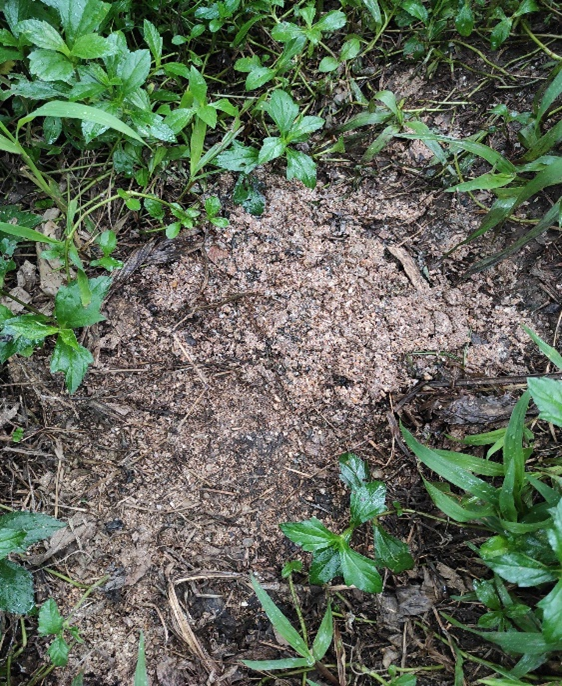
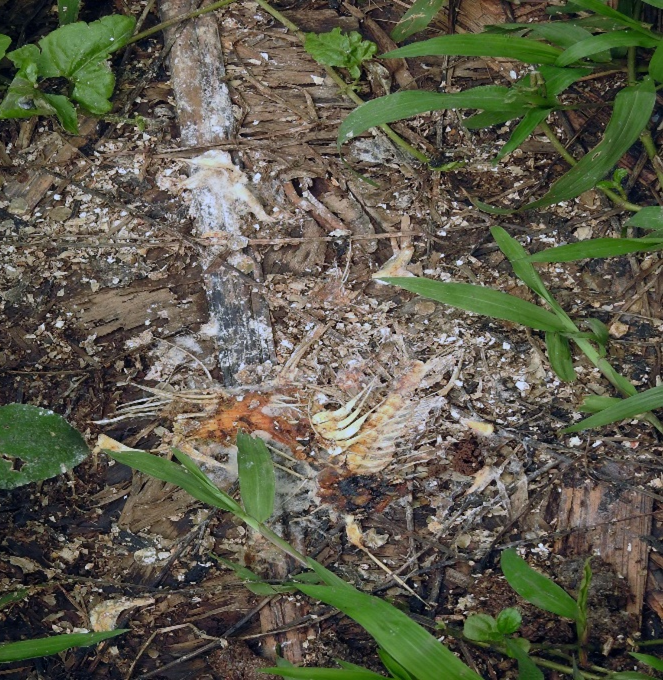
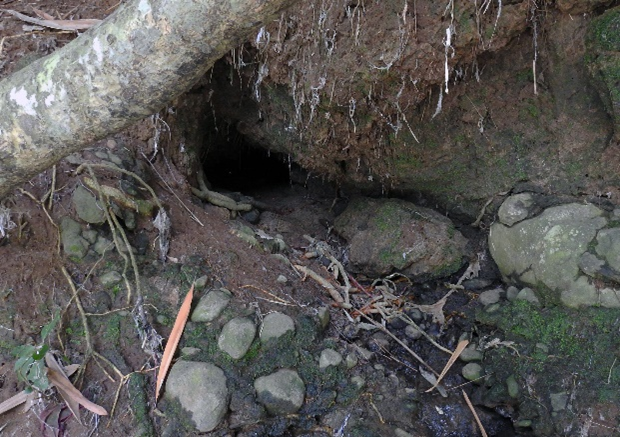
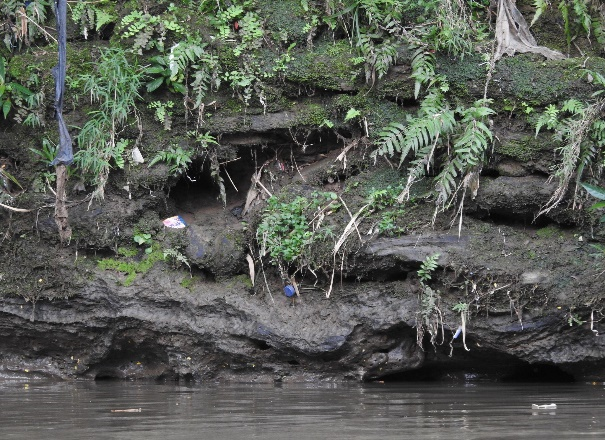
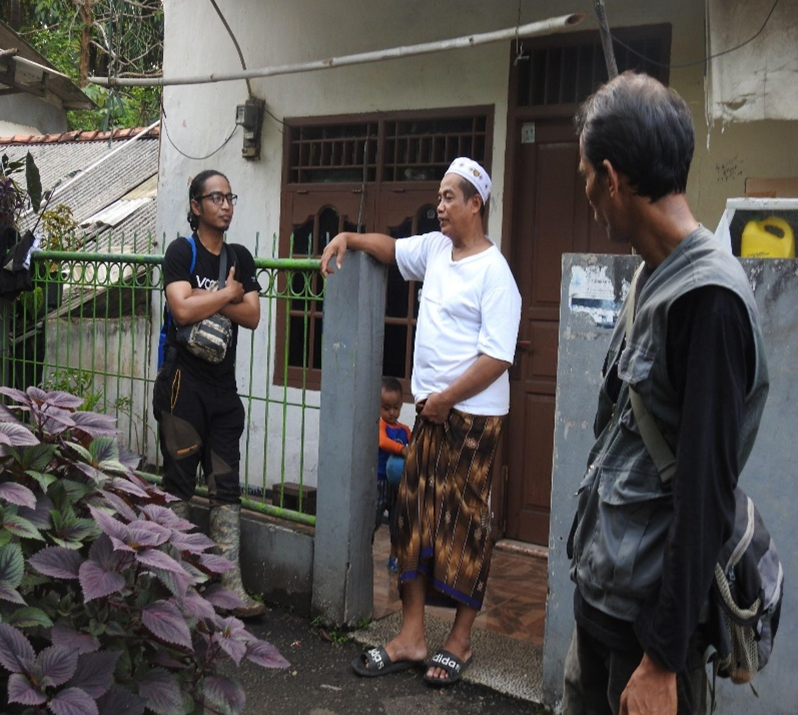
The first otter sighting occurred on 10 October 2022 at Ciliwung Bridge in Grand Depok City (-6.41139064617847, 106.81863001332647) through direct observation and documentation using a monocular IR camera (Fig. 8). At 1:30 AM, the appearance of the otters was noted. The eight otters who suddenly appeared were members of a family. Shortly after the rain stopped falling at the observation position, the family appeared. Through an infrared monocular, a video of the otter from the initial discovery was captured. The distance at which the otter was captured on camera (about 100 meters) makes its appearance less distinct.
The second encounter happened on October 14, 2022 at Blue Bridge (6.445377108424671, 106.81277815442608) and was documented using a Nikon Coolpix P900 camera. . The two otters were searching for food along the riverbank. At that time, it was 10:00 a.m., and the area surrounding the observation point was bustling with people crossing the bridge and passing the observation point. This documentation was captured at approximately 50 m from the otters. Additionally, photographs and video recordings were taken during the activity (Fig. 9).
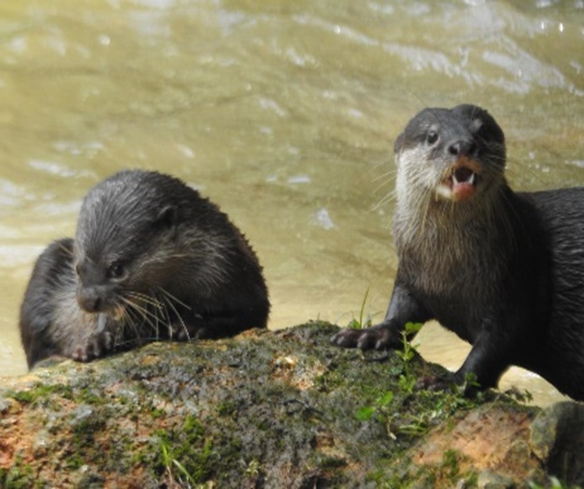
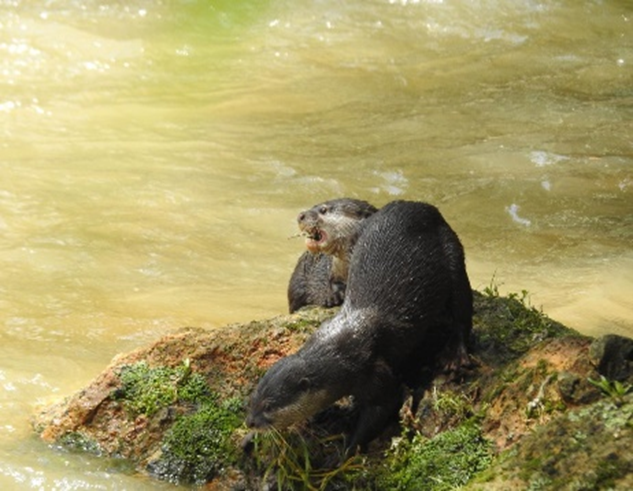
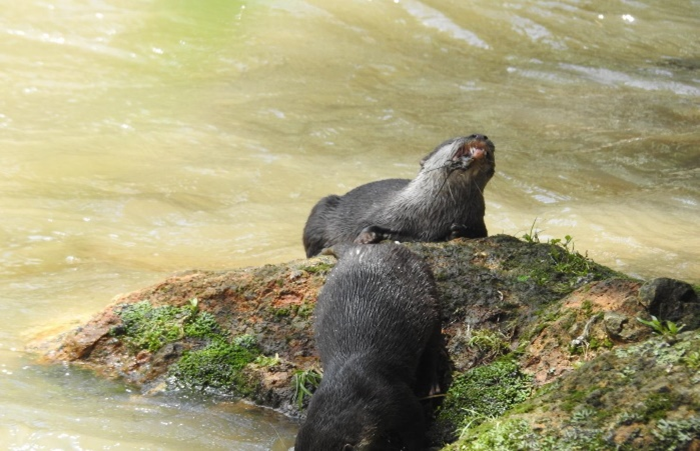
DISCUSSION
The Ciliwung River, especially segment 4 that passes through Depok City, has good vegetation with various types of tree stands such as Loa, Breadfruit, Banyan, Benda, and Bamboo species (Fig. 3). The most important thing is that the Ciliwung River still provides adequate carrying capacity for the survival of the otter, because the availability of feed in the form if fish is still quite abundant.
Informal social interviews were conducted during the survey to collect information about otters in their respective regions. To confirm their identification, participants were shown photographs of otters. Locals and fishermen lacked a precise understanding of the ecology and behaviour of otters. Their description of the otters are filled with myths and beliefs. The majority of otter activity occurs at night and during crepuscular hours (dawn and dusk), according to the interviewees.
The finding of locations for sliding and grooming sites alows us to assume that they are grooming themselves on the rocks. Typically, when the river water recedes, rocks that are currently submerged can be exposed. It will be intriguing to find out what the situation will be like when the river level rises again due to rain. The otters may be forced to relocate to higher ground, where they may be able to build dens and find places to sliding and grooming sites (Fig. 6).
This can be attributed to the abundance of otter-friendly nesting sites along the river’s banks, where numerous rocks are present. Another possible explanation is that otters do not need dens in such habitat because there is so much empty space, such as a cave between rocks, that they use as dens.
Dual sightings of Aonyx cinereus in Ciliwung River Segment 4 and numerous additional observations (latrine sites, footprints, sprains, and slide sites) in August and October 2022 indicate the presence of this species in the Jabodetabek region. However, according to the IUCN Redlist, which was last updated on February 19, 2020, Aonyx cinereus does not yet exist in that area (Fig. 10).
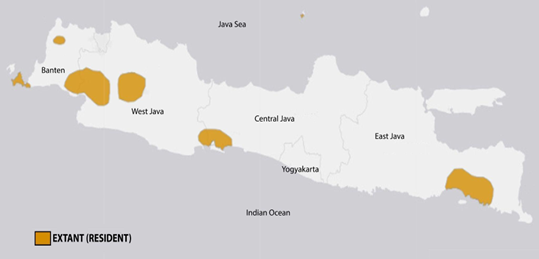
The disparity between these results is due to the absence of assessments conducted in the Java Island region or in Indonesia as a whole. This is evident from the few studies conducted in Indonesia on Aonyx cinereus (Dirgantara et al., 2021).
Maps of species distribution are important for estimating extinction risk and planning conservation efforts. Here, we attempt to perform a study that aims to contribute data on the distribution of Aonyx cinereus on the Java Island, as well as to map the distribution of the species and assess their conservation status in accordance with the IUCN Red List's rules and criteria.
The distribution of the species A. cinereus in the Ciliwung River is particularly unknown. There is a need for more monitoring and tougher supervision of this otter species, particularly to prevent its extinction by improving the effectiveness of national legislative mechanisms. As a region with high biodiversity, the region around Ciliwung is essential in establishing the viability of this function.
Aonyx cinereus and Lutrogale perspicillata are the two kinds of otters found on Java Island (Wright et al., 2015). However, Aonyx cinereus dominated our findings in segment 4 of the Ciliwung River in our study. As we all know, the Ciliwung River is not a trash-free river, but rather one that is overflowing with trash. When the rainy season arrives in Jakarta, various places are susceptible to flooding. Due to the garbage-clogged overflow of the Ciliwung River, which caused it to flood.
Small-clawed otter are adapted to live near human populations and migrate through the canal network. It was observed that otters are not habituated to human presence. Being nocturnal, most activity is observed at night in the filed areas. They are also found crossing roads in certain areas.
Tracks could be assumed as their activities occur, spraints served as a territory mark for A. cinereus, scraps were an indication of their prey hunting, and latrine sites could be used as a form of communication between species. The existence of A. cinereus activity in the region was also supported by the assertions of locals that certain locations served as A. cinereus’s playground. During nighttime observation, the voice of A. cinereus was also audible at the site.
The tracks of A. cinereus sometimes were found together with spraints. Latrines in Ciliwung watershed were distinguished by the abundance of human waste. A latrine site was discovered close to a field, in an area with no other vegetation but grass. There were differences in the vegetation between the two latrine sites, but both were discovered on dry soil rather than mud. In some of fresh and intermediate spraint, we discovered fish bones, snail, shell fragments, feathers, and fabric fibres (Fig. 5).
Nonetheless, trash does not prevent otters from inhabiting the Ciliwung River. It's not just a garbage problem; passing automobiles across the river does not prevent otters from adapting to their environment to the point where they become accustomed to vehicles passing near their habitat.
In addition to the poor quality of otter habitat in the Ciliwung River, the greatest threat to the small-clawed otter population is poaching for the pet trade (Aadrean, 2013; Gomez et al., 2019). The close proximity of Aonyx cinereus to settlements in the Jabodetabek region makes this species vulnerable to hunting, thereby threatening its survival in the wild. To discourage the hunting and trading of otters in the country, stringent punishments must be legislated and enforced, along with the protection of Aonyx cinereus and three other otter species in Indonesia.
With the observation of Aonyx cinereus in Ciliwung River Segment 4, we hope that the local community and government would boost their priority on river sustainability, whether it is cleanliness or development in the Ciliwung watershed, so that the survival of these animals in their habitat can be maintained.
This huge territory, which includes the Ciliwung River and the 13 rivers that flow through Jakarta and the surrounding metropolis, may be an important refuge for the small-clawed otter. Urgently required are follow-up and systematic surveys to collect data on otter population size, threats, and conservation strategy. It is essential to preserve the Ciliwung River so that it may be passed on to future generations. Therefore, it is anticipated that all sectors of society would contribute to maintaining the river clean.
Acknowledgements: We would like to acknowledge and extend our gratitude to Dr. Aadrean, M.Si, Wahyu Ramdhan Wijanarko, Aldio Dwi Putra, Ciliwung Depok Community, and Saung Bambon Riverside for their invaluable contributions to the research on otter distribution in the Ciliwung River. This survey is part of BW Sponsorship Program 2022.

REFERENCES
Aadrean, Salmah, S., Salsabila, A., Rizaldi., Janra, M.N. (2010). Tracks and other signs of otters in rice fields in Padang Pariaman, West Sumatra: a preliminary study. IUCN Otter Spec. Group Bulletin 27: 6-11. https://www.iucnosgbull.org/Volume27/Aadrean_et_al_2010.html
Aadrean, Novarino, W., Jabang (2011). A record of small-clawed Otters (Aonyx cinereus) foraging on an invasive pest species, Golden Apple Snails (Pomacea canaliculata) in a West Sumatra rice field. IUCN Otter Specialist Group Bulletin 28(1): 34–38. https://www.iucnosgbull.org/Volume28/Aadrean_et_al_2011.html
Aadrean. (2013). An investigation of otters trading as pet in Indonesian online markets. Jurnal Biologika 2: 1-6. https://jurnalbiologika.files.wordpress.com/2013/12/aadrean-2013.pdf
Aadrean, Usio, N. (2017). Small-clawed otters (Aonyx cinereus) in Indonesian rice fields: latrine site characteristics and visitation frequency. Ecol Res 32: 899-908. https://doi.org/10.1007/s11284-017-1496-6
Aadrean, Usio, N. (2020). Spatiotemporal patterns of latrine-site use by Small-Clawed Otters in a heterogeneous rice field landscape. Mammal Study 45(2):103–110. https://doi.org/10.3106/ms2019-0031
Abdullah, A., Rasyid, H.A. (2015). Habitat characteristics of small-clawed otter (Aonyx cinereus) in Ujong Nga, Samatiga, West Aceh. Natural 15. http://jurnal.unsyiah.ac.id/natural/article/view/4343/3747
Allen, M.L., Sibarani, M.C., Utoyo, L. (2019). The first record of a wild hypopigmented Oriental Small-clawed Otter (Aonyx cinereus). Ecotropica 21: 201904. https://www.ecotropica.eu/index.php/ecotropica/article/view/12
Andreska, F., Novarino, W., Nurdin, J., Aadrean. (2021). Relationship between temporal environment factors and diet composition of Small-Clawed Otter (Aonyx cinereus) in heterogeneous paddy fields landscape in Sumatra, Indonesia. IUCN Otter Specialist Group Bulletin 38(2): 106–116. https://www.iucnosgbull.org/Volume38/Andraska_et_al_2021.html
Arifasihati, Y., Kaswanto. (2016). Analysis of land use and cover changes in Ciliwung and Cisadane Watershed in three decades. Proc. Environmental Sciences 33: 465-469. https://doi.org/10.1016/j.proenv.2016.03.098
Dirgantara, A.P., Megantara, E.N., Husodo, T., Febrianto, P., Wulandari, I., Shanida, S.S. (2021). The existence of Asian small-clawed otter (Aonyx cinereus Illiger, 1815) in the UCPS Hydropower, Cianjur, West Java, Indonesia. Biodiversitas 22: 4391-4401. https://doi.org/10.13057/biodiv/d221032
El Alami, A., Fattah, A., Chait, A. (2020). A Survey of the Eurasian Otter Lutra lutra and Human-Otter Interaction in the Middle Oum Er Rbia River, Morocco. IUCN Otter Specialist Group Bulletin, 37 (4): 219 -231. https://www.iucnosgbull.org/Volume37/El_Alami_et_al_2020.html
Foster-Turley, P., Santiapillai, C. (1990). Otters: An Action Plan for Their Conservation. Action plan for Asian otters. IUCN, Gland, Switzerland.
Foster-Turley, P. (1992). Conservation aspects of the ecology of Asian small-clawed and smooth otters on the Malay Peninsula. IUCN Otter Spec. Group Bulletin 7: 26-29. https://www.iucnosgbull.org/Volume7/Foster_Turley_1992.html
Fusillo, R., Marcelli, M., Boitani, L. (2007). Survey of an otter Lutra lutra population in southern Italy: site occupancy and influence of sampling season on species detection. Acta Theriologica 52 (3): 251-260. https://doi.org/10.1007/BF03194221
Gomez, L., Shepherd, C.R. (2018). Smooth-coated Otter Lutrogale perspicillata receives formal protection in Indonesia, but Small-clawed Otter Aonyx cinereus does not. IUCN Otter Specialist Group Bulletin 35(2): 128–130. https://www.iucnosgbull.org/Volume35/Gomez_Shepherd_2018.html
Gomez, L., Shepherd, C.R. (2019). Stronger international regulations and increased enforcement effort is needed to end the illegal Trade in otters in Asia. IUCN Otter Spec. Group Bull. 36: 71-76. https://www.iucnosgbull.org/Volume36/Gomez_Shepherd_2019.html
Krupa, H., Borker, A., Gopal, A. (2017). Photographic Record of Sympatry between Asian Small- Clawed Otter and Smooth-Coated Otter in the Northern Western Ghats, India. IUCN Otter Spec. Group Bull. 34(1): 51-57. https://www.iucnosgbull.org/Volume34/Krupa_et_al_2017.html
Li, F., Luo, L., Chan, B.P.L. (2019). Notes on distribution, status and ecology of Asian Small-Clawed Otter (Aonyx cinereus) in Diaoluoshan National Nature Reserve, Hainan Island, China. Proceedings of the14th International Otter Congress, IUCN Otter Specialist Group Bulletin 36A: 39–46. https://www.iucnosgbull.org/Volume36A/Li_et_al_2019.html
Macdonald, S.M., Mason, C.F. (1988). Observations on an otter population in decline. Acta Theriologica, 33(30): 415-434. https://rcin.org.pl/ibs/publication/27372
Mason, C.F., Macdonald, S.M. (1986). Otters - Ecology and Conservation. Cambridge University Press, Cambridge, London. 236 pp.
Melisch, R., Asmoro, P.B., Kusumawardhami, L. (1994). Major steps taken towards otter conservation in Indonesia. IUCN Otter Specialist Group Bulletin 10: 21–24. https://www.iucnosgbull.org/Volume10/Melisch_et_al_1994.html
Melisch, R., Kusumawardhani, L., Asmoro, P.B., Lubis, I.R. (1996). The otters of West Java – a survey of their distribution and habitat use and a strategy towards a species conservation programme. Wetlands International, Directorate General of Forest Protection and Nature Conservation, Bogor, Indonesia.
Moffatt, S.F., McLachlan, S.M., Kenkel, N.C. (2004). Impacts of land use on riparian forest along an urban–rural gradient in Southern Manitoba. Plant Ecology 174: 119-135. https://doi.org/10.1023/B:VEGE.0000046055.27285.fd
Nikhil, S., Nameer, P.O. (2017). Small carnivores of the montane forests of Eravikulam National Park in the Western Ghats, India. Journal of Threatened Taxa 9(11): 10880–10885. http://doi.org/10.11609/jott.2211.9.11.10880-10885
Noviandi, T.U.Z. (2016). Manajemen lanskap riparian sebagai strategi pengendalian ruang terbuka biru pada Sungai Ciliwung. Thesis. Bogor: IPB University. http://repository.ipb.ac.id/handle/123456789/81304
Permatasari, P.A., Setiawan, Y., Khairiah, R.N., Effendi, H. (2017). The effect of land use change on water quality: A case study in Ciliwung Watershed. In IOP Conference Series: Earth and Environmental Science 54:012026. IOP Publishing. http://doi.org/10.1088/1755-1315/54/1/012026
Prakash, N., Mudappa, D., Raman, T.S., Kumar, A. (2012). Conservation of the Asian small-clawed otter (Aonyx cinereus) in human-modified landscapes, Western Ghats, India. Trop. Conserv. Sci. 5(1): 67-78. http://doi.org/10.1177/194008291200500107
Remondi, F., Burlando, P., Vollmer, D. (2016). Exploring the hydrological impact of increasing urbanisation on a tropical river catchment of the metropolitan Jakarta, Indonesia. Sustainable Cities and Society 20: 210-221. https://doi.org/10.1016/j.scs.2015.10.001
Rihadini, R., Appel, A., Handono, C.D., Febriant, I. (2022). First Photographic Records of the Small-Clawed Otter Aonyx cinereus (Illiger, 1815) in Eastern Java, Indonesia. IUCN Otter Specialist Group Bulletin 39 (1): 3 – 14. https://www.iucnosgbull.org/Volume39/Rihadinii_et_al_2022.html
Reuther, C., Dolch, D., Green, R., Jahrl, J., Jefferies, D., Krekemeyer, A., Kucerova, M., Bo Madsen, A., Romanowsky, J., Roche, K., Ruiz-Olmo, J., Teubner, J., Trinidade, A. (2000). Surveying and monitoring distribution and population trends of the Eurasian Otter (Lutra lutra): guidelines and evaluation of the standard method for surveys as recommended by the European Section of the IUCN/SSC Otter Specialist Group. Habitat 12: 1-148.
Saridewi, T.R., Hadi, S., Fauzi, A., Rusastra, I.W. (2014). Penataan ruang Daerah Aliran Sungai Ciliwung dengan pendekatan kelembagaan dalam perspektif pemantapan pengelolaan usahatani. In Forum Penelitian Agro Ekonomi 32:87-102. http://repository.pertanian.go.id/handle/123456789/5332
Schenekar, T., Clark, A., Holzinger, W.E., Weiss, S.J. (2022). Presence of spraint at bridges as an effective monitoring tool to assess current Eurasian fish otter distribution in Austria. Eur J Wildl Res 68: 53. https://doi.org/10.1007/s10344-022-01604-8
Sreekumar, E.R., Nameer, P.O. (2018). Small carnivores of Wayanad Wildlife Sanctuary, the southern Western Ghats, India. Journal of Threatened Taxa 10(1): 11218–11225. http://doi.org/10.11609/jott.3651.10.1.11218-11225
Wright L, de Silva P., Chan B, Lubis I.R. (2015). Aonyx cinereus. The IUCN red list of threatened species 2015: e.T44166A21939068. http://dx.doi.org/10.2305/IUCN.UK.2015-2.RLTS.T44166A21939068.en
Résumé: Observation et Indices de Presence de la Loutre Cendrée (Aonyx cinereus Illiger, 1815) dans la Rivière Ciliwung, en Indonésie
La loutre cendrée (Aonyx cinereus) est classée comme vulnérable sur la Liste rouge de l’UICN et a récemment été reprise à l’Annexe I de la CITES en raison d’une réduction importante de la population et du commerce. Malgré les efforts croissants de conservation des loutres dans le monde, la conversion des terres, les déchets, les pesticides et le braconnage constituent des menaces importantes pour les populations de loutres. Des études antérieures ont identifié la présence et les caractéristiques de l’habitat d’Aonyx cinereus dans diverses régions d’Indonésie. Cependant, des recherches supplémentaires doivent encore être menées sur les espèces de la rivière Ciliwung. L’observation de terrain a été réalisée d’août à octobre 2022 ; la plupart des travaux sur le terrain ont eu lieu durant la saison des pluies, alors qu’il existe de meilleures périodes pour échantillonner les indices de présence de loutre. Les épreintes et les latrines étaient les indices de présence de loutre les plus fréquemment signalés. Deux observations directes de loutres ont été faites au cours de l’enquête, l’une d’un groupe de huit loutres à Ciliwung Bridge et l’autre de deux loutres cherchant de la nourriture le long de la berge à Blue Bridge. Nous avons confirmé la présence de loutres dans cette zone par des rencontres visuelles, des indices de présence et des observations directes. La proximité d’Aonyx cinereus des villages de la région de Jabodetabek rend cette espèce vulnérable à la chasse. Il est essentiel de préserver la rivière Ciliwung afin qu’elle puisse être transmise aux générations futures.
Revenez au dessus
Resumen: Avistaje y Signos de la Nutria de Uñas Pequeñas Asiática (Aonyx cinereus Illiger, 1815) en el Río Ciliwung, Indonesia.
La nutria de uñas pequeñas asiática (Aonyx cinereus) está clasificada como vulnerable en la Lista Roja de UICN, y ha sido recientemente subida al Apéndice I del CITES debido a su significativa reducción poblacional, y el tráfico comercial. A pesar del aumento en los esfuerzos de conservación de nutrias en todo el mundo, la conversión de la tierra, los desechos, los pesticidas, y la caza ilegal son amenazas significativas para las poblaciones de nutrias. Estudios previos han identificado la presencia y características del hábitat de Aonyx cinereus en varias regiones de Indonesia. Sin embargo, aún se necesita más investigación sobre las especies del Río Ciliwung. La observación de terreno fue llevada a cabo entre Agosto y Octubre de 2022; la mayor parte del trabajo de campo se hizo en la estación lluviosa, siendo que hay mejores períodos para muestrear marcas y signos de nutria. Los signos más comúnmente reportados fueron las fecas y los sitios de letrina. Se hicieron dos observaciones directas de nutrias durante el relevamiento, una de un grupo de ocho nutrias en el Puente Ciliwung y otra de dos nutrias buscando alimento a lo largo de las orillas del río en el Puente Azul (Blue Bridge). Confirmamos la presencia de nutrias en éste área a través de encuentros visuales, relevamientos de signos, y avistajes directos. La proximidad de Aonyx cinereus a asentamientos humanos en la región de Jabodetabek hace que ésta especie sea vulnerable a la caza. Es esencial preservar el Río Ciliwung, para que pueda pasar a las futuras generaciones.
Vuelva a la tapa
